| dc.contributor.advisor | Toliyat, Hamid A | |
| dc.creator | Farhangi, Babak | |
| dc.date.accessioned | 2015-02-05T17:24:07Z | |
| dc.date.available | 2016-08-01T05:30:19Z | |
| dc.date.created | 2014-08 | |
| dc.date.issued | 2014-07-25 | |
| dc.date.submitted | August 2014 | |
| dc.identifier.uri | https://hdl.handle.net/1969.1/153321 | |
| dc.description.abstract | Plugin Hybrid Electric Vehicles (PHEVs) propel from the electric energy stored in the batteries and gasoline stored in the fuel tank. PHEVs and Electric Vehicles (EVs) connect to external sources to charge the batteries. Moreover, PHEVs can supply stand-alone loads and inject power to the grid. Such functionalities have been defined as Vehicle to House (V2H) and Vehicle to Grid (V2G) and promoted by national and international policies such as the Energy Independency and Security Act (EISA) of 2007, enacted by the United States Congress. Exchanging energy between the vehicle
and external sources is performed by the vehicular power conditioner (VPC). This dissertation proposes a design procedure for VPCs. The research mainly focuses on the VPC’s power converter design.
A conceptual design approach is proposed to select the proper power converter topologies according to the determined power conditioning needs. The related standards and previous works are reviewed to determine the design guidelines. A set of specifications are introduced for a three port onboard VPC. This VPC is a reference for designs, simulations and experiments.
The reference VPC is implemented with a modular three-stage isolated topology that utilizes voltage source ac-dc converters as the power conditioning stages. The multiport extension of this topology extends the vehicular power conditioning concept into a novel vehicular integrated power system. All the vehicle’s electric sources and loads can exchange energy in the described multiport integrated power system.
Novel design methods are proposed for the power converter, filters, magnetic circuit and control of the VPC. The practical challenges of the VPC development are analyzed. The major contributions of this dissertation include a pioneer grounding scheme for VPC considering the vehicular standards, a novel modeling approach for the Snubberless Dual Active Bridge (DAB) commutation, an innovative integrated ac inductor, and a new experimental modeling method for multiwinding transformers. The
contributions are supported by analyses, simulations, and practical experiments. | en |
| dc.format.mimetype | application/pdf | |
| dc.language.iso | en | |
| dc.subject | Power Electronics | en |
| dc.subject | Magnetic Circuits | en |
| dc.subject | Power Converters | en |
| dc.subject | Isolated Dc-Dc Converters | en |
| dc.subject | Multiport Converters | en |
| dc.subject | Grid-Tied Inverter | en |
| dc.subject | Connected Vehicles | en |
| dc.subject | Charger | en |
| dc.subject | Vhicle to Grid (V2G) | en |
| dc.subject | Ac Inductors | en |
| dc.subject | High Frequency Multiwinding Transformer | en |
| dc.subject | Automotive Grounding | en |
| dc.subject | Digital Embedded Control | en |
| dc.title | Power Conditioning for Plug-In Hybrid Electric Vehicles | en |
| dc.type | Thesis | en |
| thesis.degree.department | Electrical and Computer Engineering | en |
| thesis.degree.discipline | Electrical Engineering | en |
| thesis.degree.grantor | Texas A & M University | en |
| thesis.degree.name | Doctor of Philosophy | en |
| thesis.degree.level | Doctoral | en |
| dc.contributor.committeeMember | Bhattacharyya, Shankar P | |
| dc.contributor.committeeMember | Butler-Purry, Karen L | |
| dc.contributor.committeeMember | Zoghi, Behbood B | |
| dc.type.material | text | en |
| dc.date.updated | 2015-02-05T17:24:07Z | |
| local.embargo.terms | 2016-08-01 | |
| local.etdauthor.orcid | 0000-0002-2595-9045 | |


